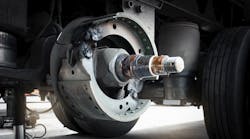Since 1998, the Commercial Vehicle Safety Alliance (CVSA) has conducted Brake Safety Week, the annual commercial motor vehicle brake-safety inspection, enforcement, and education initiative conducted by law enforcement jurisdictions in Canada, Mexico, and the U.S.
From Aug. 21 to Aug. 27, inspectors will conduct their usual North American Standard Level I and IV inspections to capture data. Brake-related violations make up the largest percentage of all out-of-service vehicle violations cited during roadside inspections.
See also: How to prepare for Brake Safety Week
According to the CVSA, inspectors will examine brake systems for any issues, such as loose, broken, rusted, or missing parts, including the spring system in the parking brake as well as warning devices. They also will listen for air leaks around components and lines, check for S-cam flip-over, measure pushrod travel, and verify that slack adjusters and air chambers are accurate sizes. In addition, they will ensure the breakaway system is operable on the trailer and inspect the tractor protection system, including the bleed-back system.
If necessary, inspectors will take vehicles out of service for violations. According to the CVSA, during 2021’s International Roadcheck, brake-related violations accounted for 38.9% of all vehicle out-of-service violations. During last year’s Brake Safety Week, 12% of the vehicles inspected were placed out of service.
It baffles me that out-of-service violations are so high when we have plenty of warning that these inspection blitzes are going to take place. In the past, I have written about what fleets can do to prepare for Brake Safety Week to avoid being taken out of service.
See also: 5 questions fleets should ask to reinforce safe driving
This time I would like to challenge you to examine data from any of your vehicles that are pulled over and inspected during Brake Safety Week. Look at the reasons for the violations and pay close attention to the specific reasons vehicles were taken out of service. Then use that data to review your pre- and post-trip inspection procedures. Can they be changed to do a better job of spotting the particular brake-related issues your fleet may be having?
Look at your preventive maintenance inspections and adjust those as needed so they address the areas where you may be having issues. Use the data from this year’s Brake Safety Week inspection to determine if you need some refresher training for your technicians concerning brake maintenance and repair.
Don't look at Brake Safety Week as just another safety blitz. It is a golden opportunity to fine-tune your inspection, maintenance and repair processes to make your fleet one of the safest on the road.
Jane Clark is vice president of member services for NationaLease. In this position, she is focused on managing the member services operation as well as working to strengthen member relationships, reduce member costs, and improve collaboration within the NationaLease supporting groups. Prior to joining NationaLease, Clark served as area vice president for Randstad, one of the nation’s largest recruitment agencies, and before that, she served in management posts with QPS Cos., Pro Staff, and Manpower Inc.



